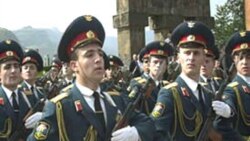By Armen Zakarian in Prague, Hrant Aleksanian in Stepanakert and Shakeh Avoyan
The foreign ministers of Armenia and Azerbaijan were due to meet in Strasbourg late Wednesday for further peace talks that coincided with the tenth anniversary of a Russian-mediated ceasefire agreement that stopped the 1991-94 war for Nagorno-Karabakh. The talks were scheduled to take place on the sidelines of a meeting of the Committee of Ministers, the main decision-making body of the Council of Europe. Vartan Oskanian and his recently appointed Azerbaijani counterpart Elmar Mamedyarov were to meet for the second time in two months in the presence of French, Russian and U.S. mediators.
“Our meeting has no agenda. The parties can bring up any issue,” Oskanian told RFE/RL from Strasbourg.
Oskanian said earlier that the two ministers will have “clear instructions” from their presidents on “putting the negotiations on a certain basis.” “We see positive movement and believe that there will be a continuation,” he told reporters in Yerevan.
Oskanian based his cautious optimism on a meeting in Warsaw late last month between Presidents Robert Kocharian and Ilham Aliev. Both leaders said the encounter was useful, but shed no light on chances of a peaceful resolution of the Karabakh conflict.
Mamedyarov said in Baku on April 30 that the two sides are currently discussing the possibility of a phased settlement that would lead to an Armenian withdrawal from Azerbaijani districts around Karabakh before an agreement on the disputed region's status. "We are discussing various ideas, including the option of opening the railway with Armenia in exchange for it pulling back from the seven districts of Azerbaijan it has occupied," he said.
Official Yerevan has until now insisted on a comprehensive peace accord that would resolve all contentious issues, including Karabakh’s status. “I see no point in discussing such an issue,” Oskanian said of Baku’s preferred strategy of conflict resolution.
The so-called step-by-step approach was strongly favored by Armenia’s previous leadership, with former President Levon Ter-Petrosian throwing his weight behind a corresponding peace proposal put forward by the American, French and Russian co-chairs of the OSCE Minsk Group in 1997. That position put Ter-Petrosian at loggerheads with his key ministers, including Kocharian, then prime minister.
Members of Ter-Petrosian’s inner circle on Wednesday again defended the phased settlement and accused the Kocharian administration of failing to deliver on its 1998 pledge to win international recognition of Karabakh’s de facto independence. One of them, former National Security Minister David Shahnazarian, said the Armenian side must be interested in a quick solution because time favors oil-rich Azerbaijan.
Joining calls for a compromise solution to the dispute was Per Gahrton, the European Parliament’s chief rapporteur on the South Caucasus. “It’s time for [the Armenian and Azerbaijani presidents] to take a jump from general talking to concrete proposals,” he said in Yerevan. “They must dare to come back to their peoples with compromises.”
“You never make peace with one party getting its demands fulfilled,” Gahrton added. “It’s impossible. Both parties must give up some of their demands.”
In Stepanakert, the Foreign Ministry of the unrecognized Nagorno-Karabakh Republic (NKR) called on Armenia and Azerbaijan as well as the international mediators to “reaffirm their commitment to maintaining the ceasefire regime.” A ministry statement said the conflicting parties should also consider signing a permanent “peace agreement” that would create an “atmosphere of trust” between them.
“I am convinced that our military personnel will continue to respect the ceasefire because we want it more [than Azerbaijan],” the deputy of the NKR Defense Army, General Vladik Khachatrian, told RFE/RL.
The ceasefire agreement was signed in Moscow on May 12, 1994 by the defense ministers of Armenia, Azerbaijan and Russia as well as the commander of the Karabakh Armenian forces. It formally came into force four days later, leaving the Armenian side in control of almost the whole of Karabakh and large swathes of territory in Azerbaijan proper. At least 20,000 people were killed and about one million others left homeless during two-and-a-half years of fierce fighting.
The agreement was preceded by the signing in Kyrgyzstan’s capital Bishkek on May, 1994 of an Armenian-Azerbaijani “protocol” that laid the groundwork for the truce. Former parliament speaker Babken Ararktsian, who signed the protocol on behalf of Armenia, said it followed nearly 20 hours of talks. “Resources were almost depleted and the parties realized that some way out needs to be found,” he recalled at a news conference.
“I consider this a great achievement first of all because the mass human losses suffered by both the Armenians and the Azerbaijanis were effectively stopped,” said Shahnazarian.
Azerbaijan’s Aliev, meanwhile, marked the 10th anniversary of the end of fighting by saying his country's army is prepared to go to war to win back Karabakh. "We must increase our military potential,” he said, according to AFP. “Our army is able at any moment to free our territory. We have every right to do that, to restore our territorial integrity, and international law is on our side since Armenia violated all international norms.”
Aliev, who was speaking as he inspected a military base in the Nakhichevan exclave, added that government expenditure on Azerbaijan's military is increasing each year, “and it will keep increasing in the future.”
(Photolur photo: Karabakh soldiers parading in Stepanakert in 2002.)




